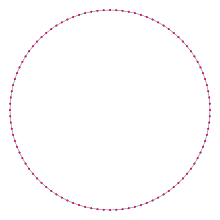Hectagon
| Regular hectogon | |
|---|---|

A regular hectogon
|
|
| Type | Regular polygon |
| Edges and vertices | 100 |
| Schläfli symbol | {100}, t{50}, tt{25} |
| Coxeter diagram |
|
| Symmetry group | Dihedral (D100), order 2×100 |
| Internal angle (degrees) | 176.4° |
| Dual polygon | Self |
| Properties | Convex, cyclic, equilateral, isogonal, isotoxal |
In geometry, a hectogon or hecatontagon or 100-gon is a hundred-sided polygon. The sum of any hectogon's interior angles is 17640 degrees.
A regular hectogon is represented by Schläfli symbol {100} and can be constructed as a truncated pentacontagon, t{50}, or a twice-truncated icosipentagon, tt{25}.
One interior angle in a regular hectogon is 176 2⁄5°, meaning that one exterior angle would be 3 3⁄5°.
The area of a regular hectogon is (with t = edge length)
and its inradius is
The circumradius of a regular hectogon is
Because 100 = 22 × 52, the number of sides is neither a product of distinct Fermat primes nor a power of two. Thus the regular hectogon is not a constructible polygon. Indeed, it is not even constructible with the use of neusis or an angle trisector, as the number of sides is neither a product of distinct Pierpont primes, nor a product of powers of two and three.
The regular hectogon has Dih100dihedral symmetry, order 200, represented by 100 lines of reflection. Dih100 has 8 dihedral subgroups: (Dih50, Dih25), (Dih20, Dih10, Dih5), (Dih4, Dih2, and Dih1). It also has 9 more cyclic symmetries as subgroups: (Z100, Z50, Z25), (Z20, Z10, Z5), and (Z4, Z2, Z1), with Zn representing π/n radian rotational symmetry.
...
Wikipedia
